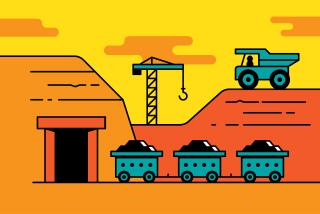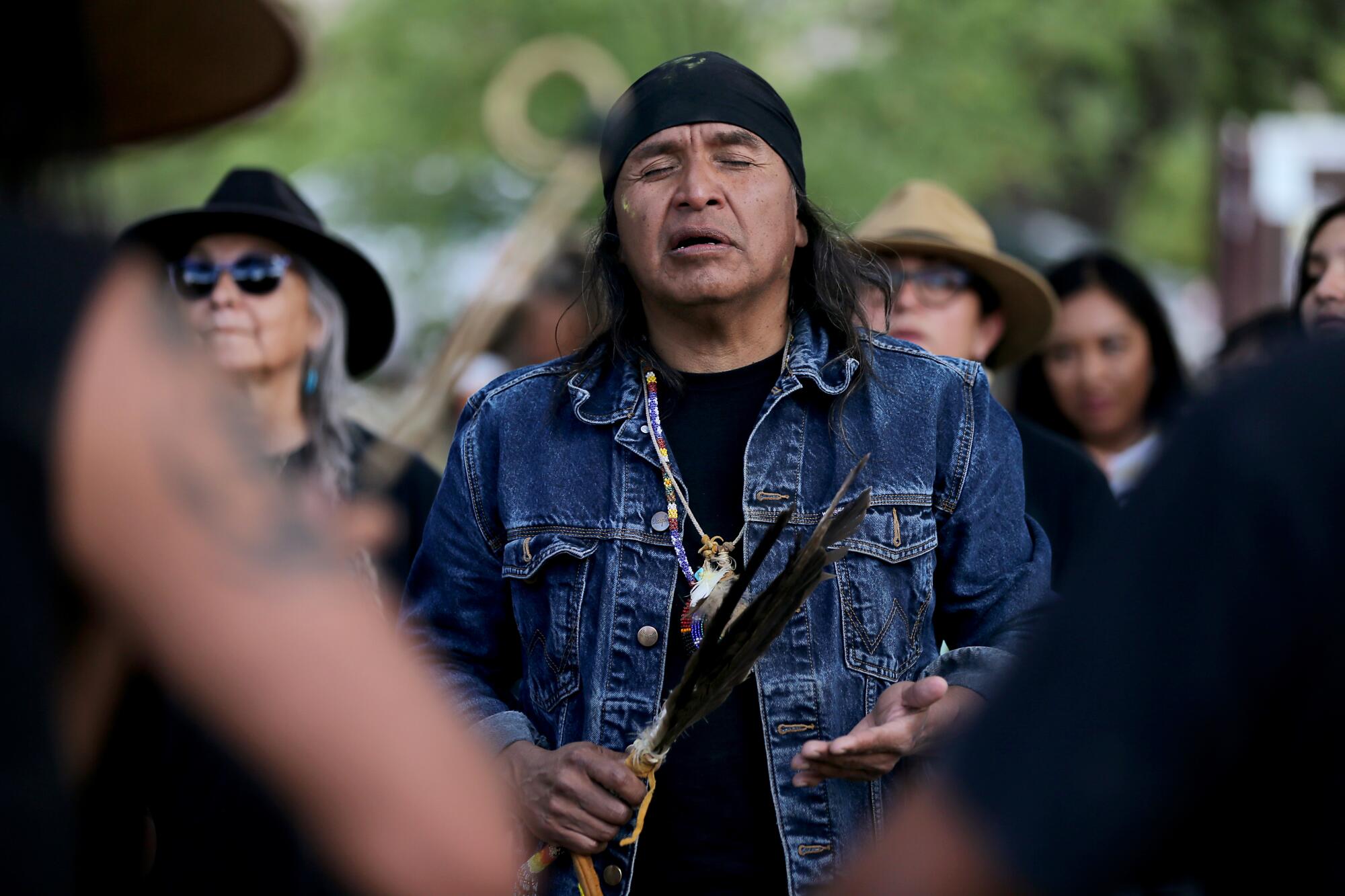
OAK FLAT, Ariz. — On a recent morning about an hour outside Phoenix, the pounding of tribal drums reverberated across the desert from a stand of oaks in the Tonto National Forest, where nearly 20 men had packed into a squat green sweat lodge to pray.
Members of several Native American tribes, the men had come to take part in the grueling spiritual ceremony under the guidance of Wendsler Nosie Sr., 64, an Apache elder who has emerged in recent years as an influential religious and environmental activist — not only in this small pocket of Arizona, but nationally.
“The spirits of our ancestors are right here,” Nosie told the men as they crawled shirtless and dripping with perspiration from an initial round of song and prayer in the sweltering lodge.
“We’re fighting the United States. We’re fighting Rio Tinto,” Nosie said, referring to the multinational mining company that wants to excavate the surrounding desert — which the Apache consider sacred — to reach a massive copper ore deposit below.

“We’re doing it,” Nosie said, “for Mother Earth.”
His fight to stop the mine sits at the forefront of modern political debate over the proper role of religion in society. It pits the American promise of religious liberty against federal land rights, corporate profits, local jobs and the ravenous global demand for natural resources such as copper — an essential element in the proliferation of telecommunications networks, electric vehicles and other technologies.
Along with others from the nearby San Carlos Apache Indian Reservation, Nosie sued to block a pending federal land swap that would hand this area, called Oak Flat, over to Rio Tinto and its mining partner, BHP Group, after being under explicit federal protection since 1955.
Oak Flat is a cactus-covered, sun-baked landscape of pinnacled rock formations and Native American archaeological and burial sites, home to a plethora of plants and animals. The deal with Resolution Copper, a Rio Tinto and BHP subsidiary, would transform it into a nearly two-mile-wide, 1,000-foot-deep industrial crater, according to federal planning records.
Apache roamed Oak Flat, which they call Chí’chil Biłdagoteel, for generations before white settlers forced them onto reservations. Nosie and the other Apache involved in the case — who go by the name Apache Stronghold — say it is sacred land blessed by their Creator and home to spiritual guardians akin to angels.
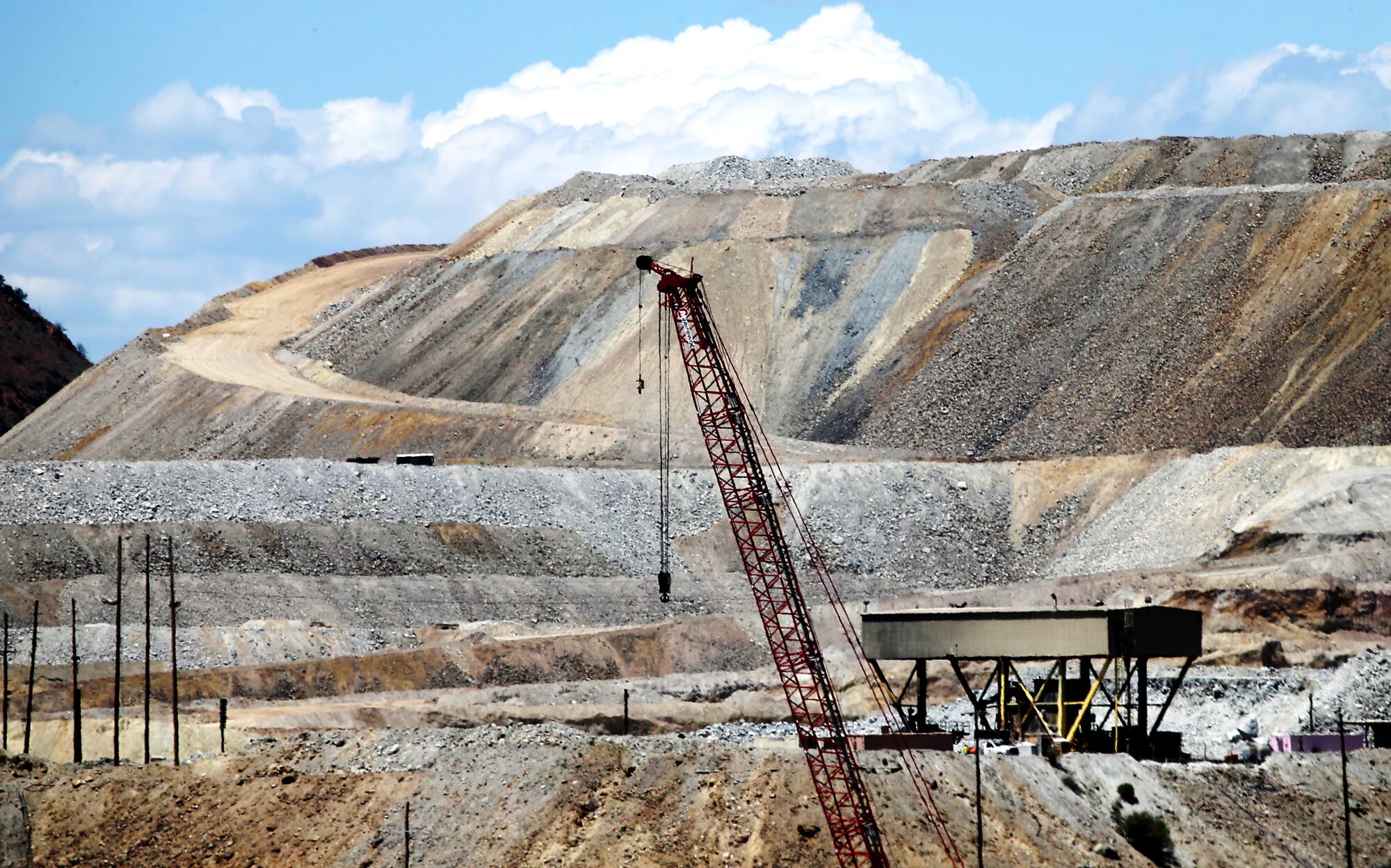
Backers of the mine have questioned the Apaches’ religious ties to the land and praised the project for the economic benefits it would bring to this struggling part of Arizona and the reservation, where unemployment and poverty run high. The mining companies have said they have sought the input of Native American partners, including Apache, and made substantial concessions to preserve particularly sensitive and important areas.
“We look forward to continuing to work closely with all stakeholders as we develop one of the most sustainable American copper mines, providing vital materials for the clean energy transition and bringing jobs and lasting economic benefits to rural Arizona,” Resolution Copper said in a statement to The Times.
To this day, the Apache say, they forage here for traditional foods such as acorns and for medicinal plants they believe are imbued with special powers. They also gather here for religious rites, including sweats and coming-of-age ceremonies known as Sunrise Dances, in which young girls are ushered into womanhood. In the Apache spiritual tradition, holy places are not bricks-and-mortar constructs such as churches, but ancient landscapes like Chí’chil Biłdagoteel.
In their lawsuit — which is now before the U.S. 9th Circuit Court of Appeals — the group argues that the deal to trade Oak Flat to Resolution Copper in exchange for other lands scattered throughout the state violates their religious rights. They say construction of the mine would prevent them from conducting their religious ceremonies and break their ties to the land forever, in violation of an 1852 treaty between the Apache and the U.S.
“We’re standing on religious belief,” Nosie told about 50 people who had gathered for an update on the case after the sweat. “We’re standing on God the Creator.”
The land
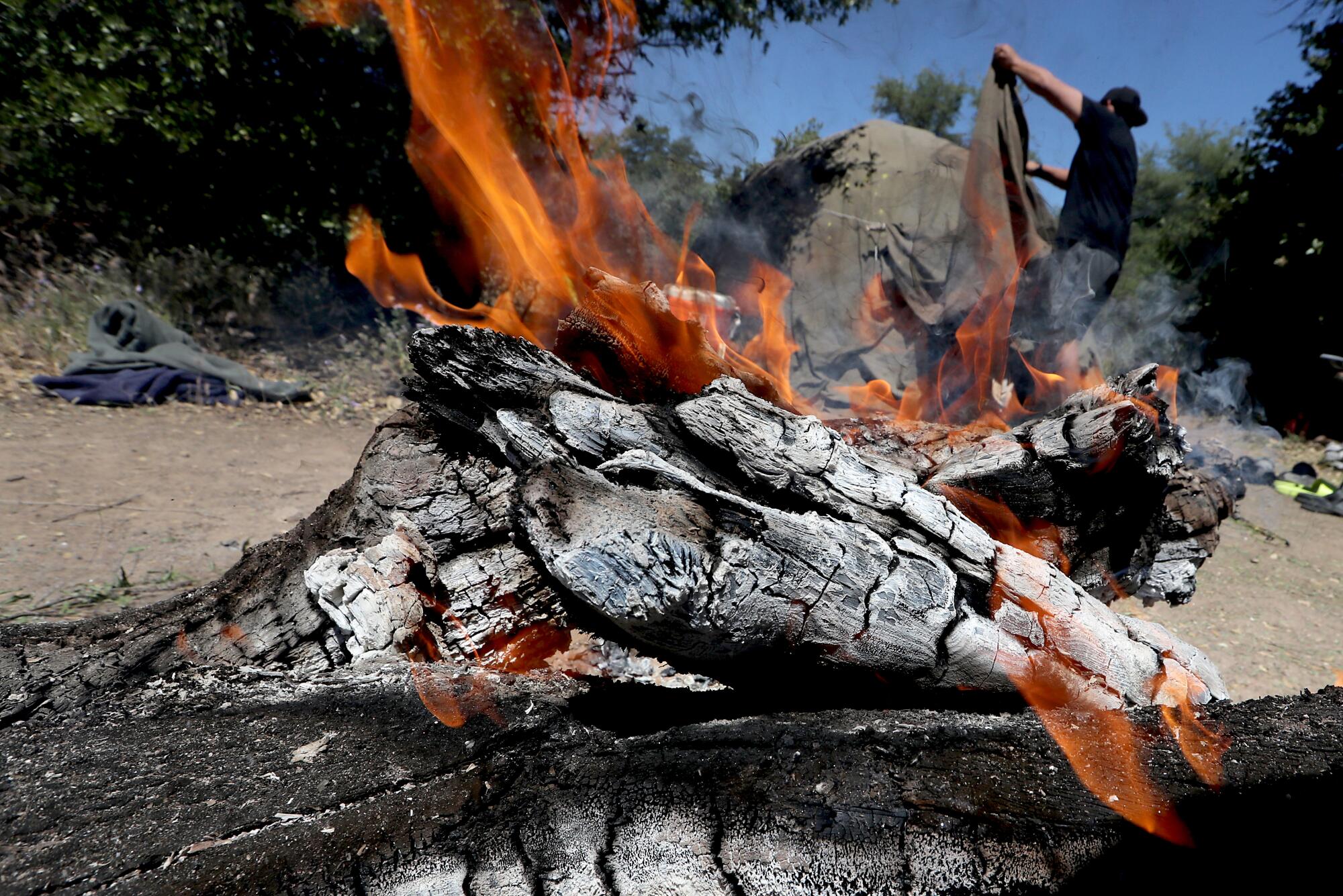
About 60 miles east of Phoenix, the old mining town of Superior sits near the foot of an ancient rock outcropping called Apache Leap, where legend holds that a band of warriors once jumped to their deaths rather than be captured by U.S. cavalry.
Up a steep canyon and through a highway tunnel sits Oak Flat, which is listed in the National Register of Historic Places for its significance to Indigenous tribes. Accessed by day-trippers and other visitors through Oak Flat Campground, the area features world-class rock climbing sites and campgrounds that local residents use for holiday picnics.
Long before any of its modern uses, however, this land was Apache territory — part of a vast swath of the Southwest that tribes called home before the encroachment of Spanish explorers, Mexican vaqueros and a growing wave of white settlers and U.S. government forces after the end of the Mexican-American War in 1848.
For decades after, the U.S. government and the Apache were at war, with the government killing raiding bands of Apache warriors and forcing other tribe members onto reservations.
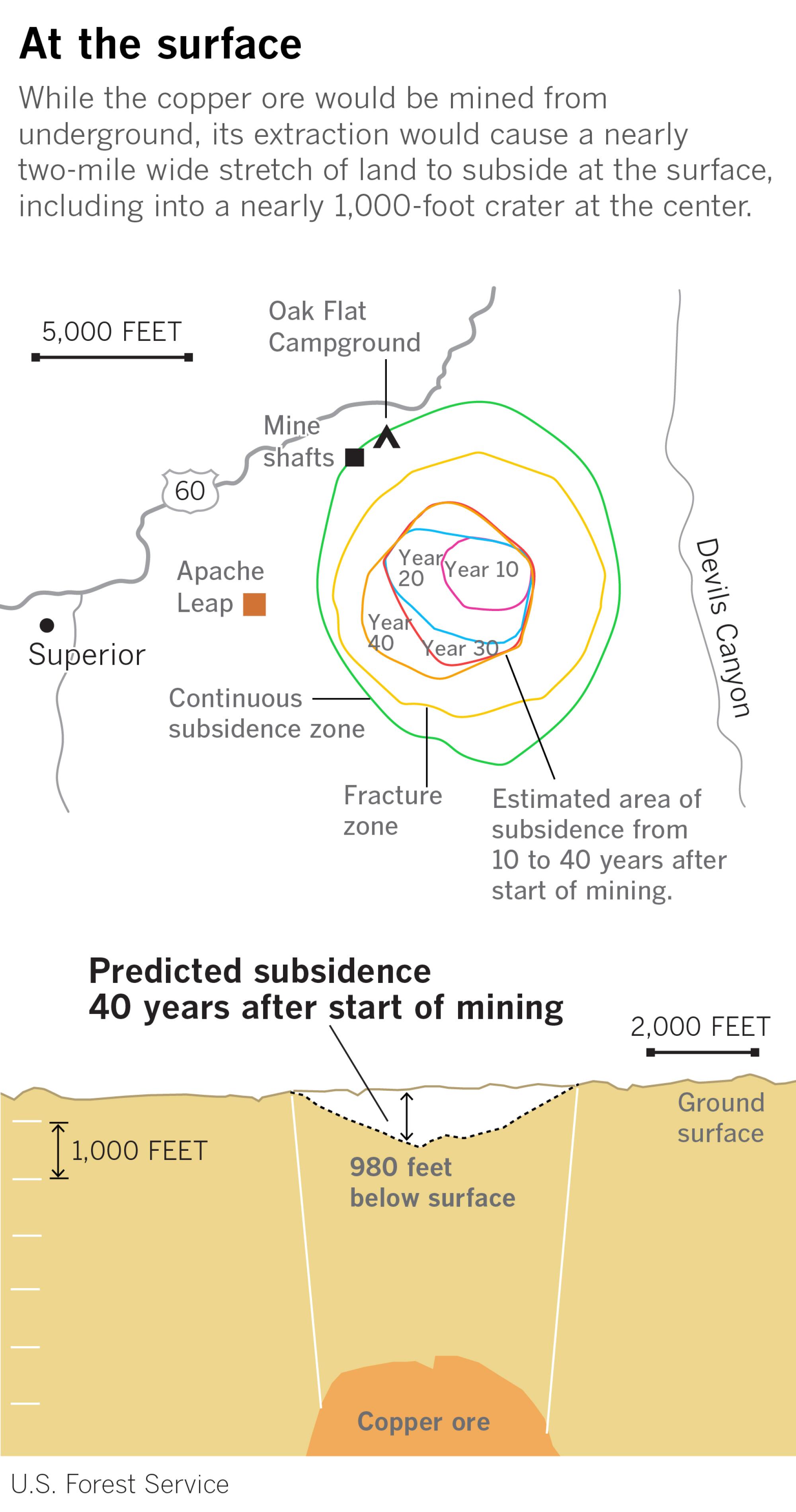
Although an 1852 treaty with the U.S. called on the government to create reservations and pass laws “conducive to the prosperity and happiness” of the Apache, that was not to be the case. Instead, their people were made prisoners of war, Apache Stronghold argues.
“American history and the land in Arizona is stained with the blood of Apache women, men, elders and children, hunted down on the Apache’s own Treaty lands and individually killed and mass-murdered in family groups by European and Euroamerican colonists, ‘settlers,’ ‘prospectors,’ miners, and agents of the United States of America,” the group wrote in its lawsuit.
In 1871, the San Carlos Apache Indian Reservation was established about 25 miles east of Oak Flat, in an area the Apache referred to as “Hell’s 40 Acres” for its miserable conditions. Tribe members faced punishment and even death if they left, particularly if they attempted to practice their religion outside the reservation, Apache Stronghold says.
The next year, the Mining Law of 1872 declared mineral deposits under federal lands open for exploration and purchase, and in 1875 the Silver Queen Mine — which would later become the Magma copper mine — was built on the edge of Oak Flat.
Today, critics of Apache Stronghold, including some longtime residents of Superior, question the group’s religious claims to the land, saying they never saw Apache at Oak Flat until the fight over the new mine began. But members of Apache Stronghold strongly dispute that.
They say that their people were brutally removed from Oak Flat in the past, but that they never stopped traveling there from the reservation — despite the threats they faced for doing so.
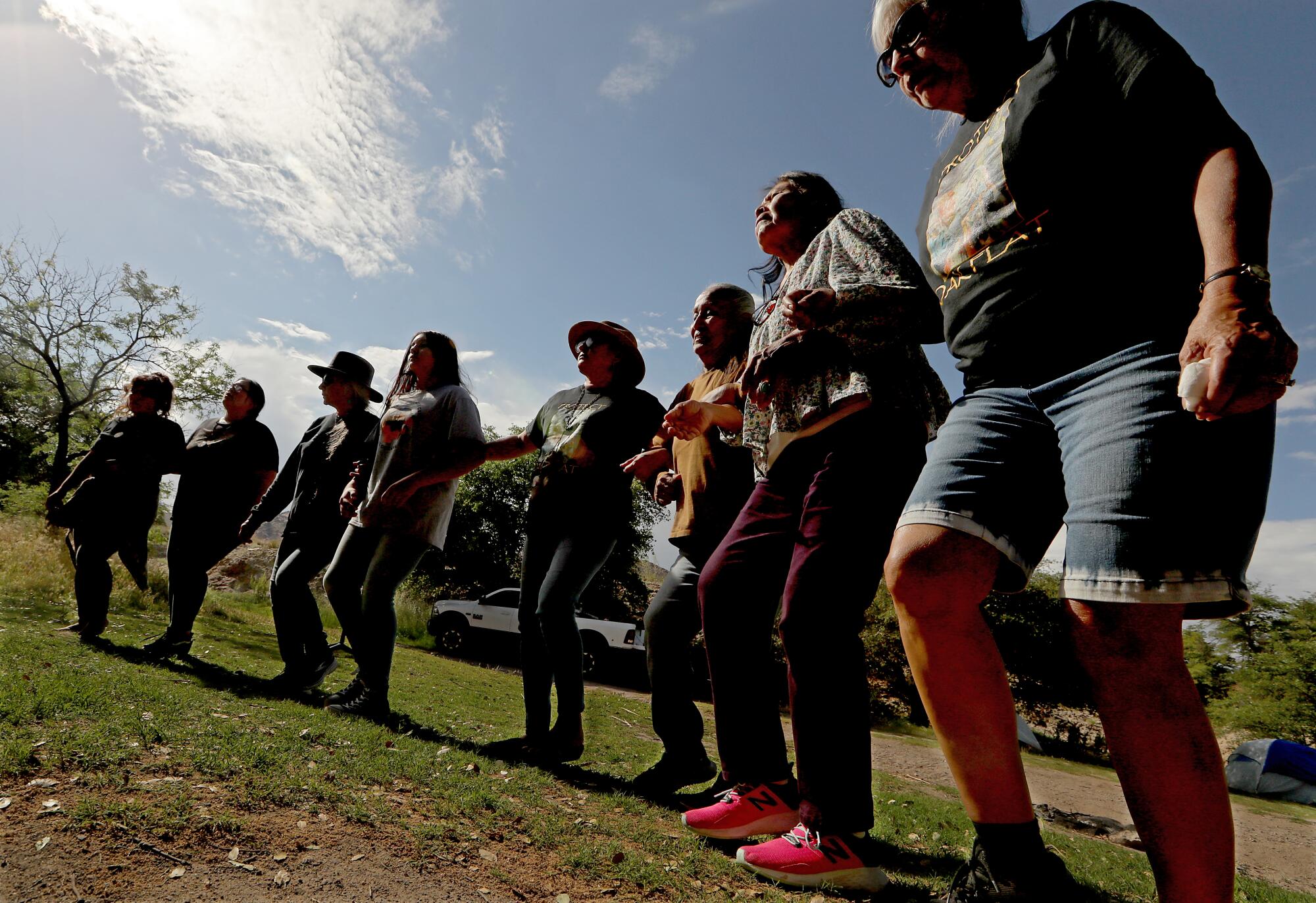
“Since I was young we’ve always come here,” Lian Bighorse, one of Nosie’s daughters, said as she and other women cooked a big meal — including acorn stew — for the gathering after the sweat. “We played all through here. Prayed. My kids grew up here, came for ceremonies.”
Bighorse, 45, who holds a bachelor’s degree in American Indian studies and a doctorate in bioethics, sustainability and global public health, said it’s difficult to describe the importance of Oak Flat because it’s “more an experience than an explanation.”
“Sublime is what I think is the best word,” she said. “It’s the presence of God.”
According to researchers contracted by Resolution Copper to conduct an ethnographic study of the region in 2014 and 2015, Chí’chil Biłdagoteel is undoubtedly significant — not just for the Apache but for Hopi, O’odham, Yavapai and Zuni.
Through interviews with tribal elders, a review of historical records and other research, principal investigator T.J. Ferguson — a professor emeritus at the University of Arizona — and his colleagues found “landforms and resource collection areas with Apache place names, Apache camps, ancestral archaeological sites, petroglyph sites, and trails” at Oak Flat, as well as dozens of natural springs and various plants and animals that “possess traditional cultural significance.”
“The proposed destruction of Oak Flat,” the researchers wrote Congress in 2021, “is akin to tearing out pages from a history book in the library.”
The mine
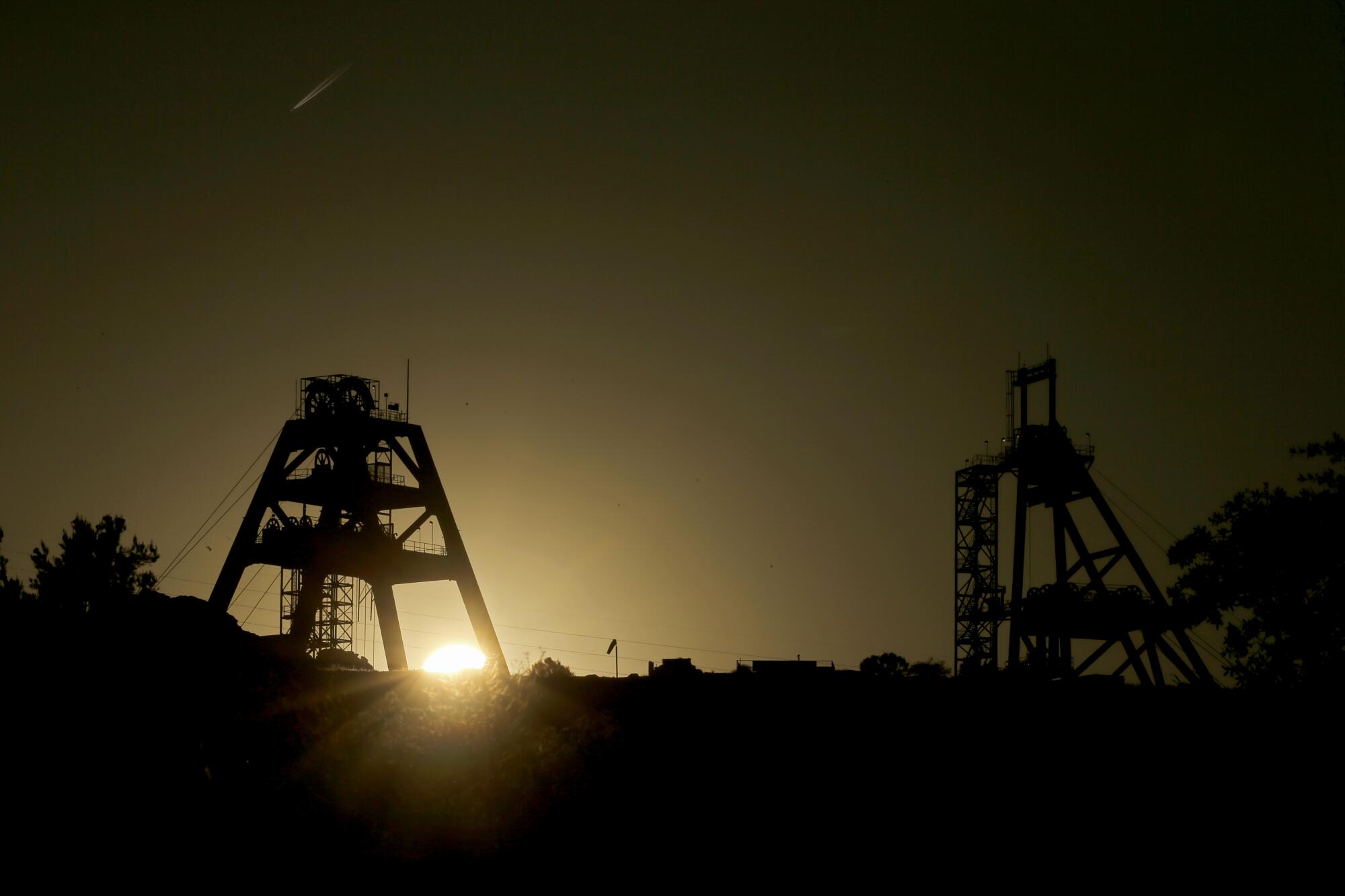
In 1910, a man named William Boyce Thompson acquired the old Silver Queen Mine and formed Magma Copper Co. — which mined copper from the area, with varying intensity, until 1996.
In 2004, companies exploring the area discovered a huge copper ore deposit beneath Oak Flat. Located between 5,000 and 7,000 feet below the surface, the deposit is now considered one of the largest untapped copper deposits in the world.
In 2006, Resolution Copper — 55% owned by Rio Tinto, 45% by BHP — began work to reclaim the historic Magma mine. The company also began lobbying Congress to undo the protections that President Eisenhower had placed on Oak Flat in 1955 and enable it to acquire the land.
For years, stand-alone legislation to initiate such a land swap failed. Then in 2014, Arizona lawmakers — including the late Sen. John McCain and former Sen. Jeff Flake — managed to insert language requiring the swap into a last-minute defense appropriations bill.
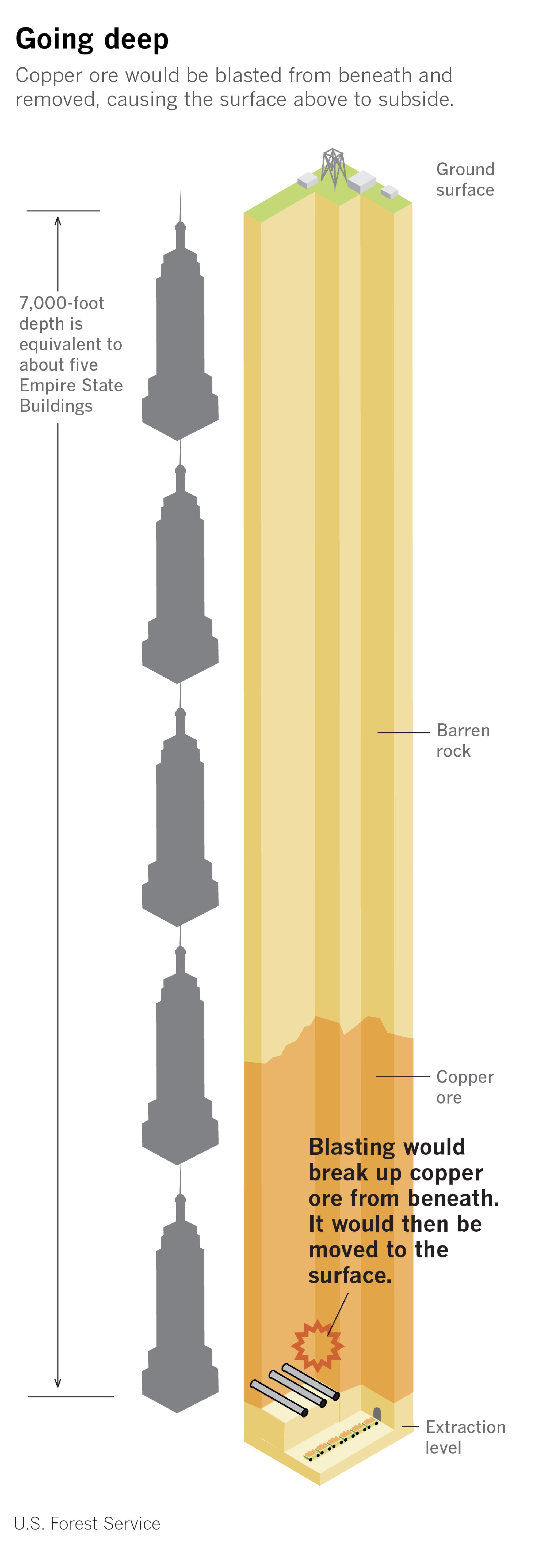
The defense bill was considered must-pass legislation, and President Obama signed it into law — formally requiring the transfer of Oak Flat to Resolution Copper upon the completion of a federal environmental study.
McCain and Flake couched the swap as a win for military readiness, as “America’s armed forces need stable supplies of copper for their equipment, ammunition, and electronics.” Opponents derided it as underhanded, slipped through Congress by deceit rather than consensus.
Either way, the move set in motion years of intense planning by Resolution Copper — which says it has already spent more than $2 billion on the project — and kick-started the U.S. Forest Service’s environmental review, which is still underway.
Resolution Copper has done extensive core sampling in the area, deepened the Magma mine shaft from about 4,800 feet to nearly 7,000 feet, and built a second shaft of the same depth next to it.
Pending the land swap going through and the completion of additional study of the ore deposit, Resolution Copper says it will build out a much larger network of shafts and tunnels, bore under the ore at a depth of about 7,000 feet — like five Empire State buildings stacked atop one another — and begin excavating it using a gravity-assisted process known as “block caving.”
An estimated 1.4 billion tons of ore, containing an estimated 40 billion pounds of copper, will be exploded into small pieces and hauled out. As that occurs, the land above — Oak Flat — will begin to subside, collapsing in on itself until it yawns into a crater “between 800 and 1,115 feet deep and roughly 1.8 miles across,” according to the environmental study.
Over its 60-year life span, the mine would require vast amounts of water, which Resolution Copper would draw in part from already limited state water supplies. The project would also require Resolution Copper to mitigate damage to springs and other natural water systems within the mine’s footprint, to ensure water bound for neighboring communities isn’t tainted.
In addition, Resolution Copper would have to create and manage a massive storage facility for the mine’s tailings, or the ore byproduct after all the valuable metals and minerals are extracted.
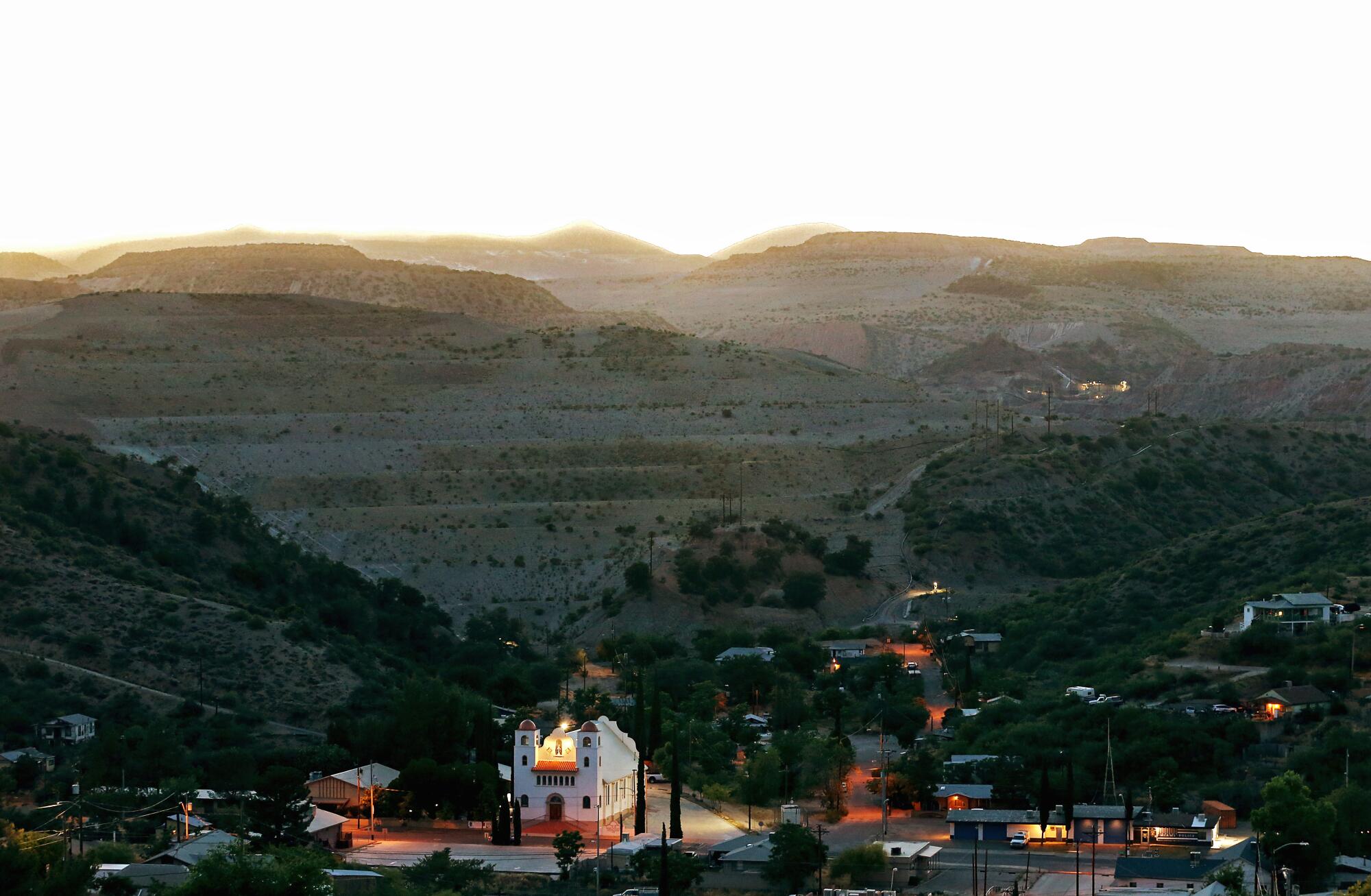
Tailings are hazardous, as they can contain substances such as lead and arsenic, and must be contained in a monitored site in perpetuity. According to the environmental study, the preferred location is an area known as Skunk Camp, which is adjacent to other mining operations to the southeast.
A tailings facility at Skunk Camp would require Resolution Copper to build more than 20 miles of pipelines from Oak Flat and pump the tailings there as a slurry. The facility and pipelines would disturb nearly 15,000 acres of land — including about 2,500 acres of federal land and more than 8,200 acres of state land — and feature a nearly 500-foot-tall embankment, according to the environmental review.
Resolution Copper says that after mining is finished, it would restore native vegetation and a more natural surface variance to make it appear less disturbed, or repurpose it as something that wouldn’t require much human activity on site, such as a solar farm.
In its statement to The Times, Resolution Copper said “hundreds of consultations with Native American Tribes” in the last decade have resulted in significant project changes “to avoid dozens of areas of cultural significance and hundreds of ancestral sites, medicinal plants, seeps and springs.”
The company noted it has agreed not to mine under Apache Leap, to ensure it is permanently preserved. The company also said the Oak Flat Campground will be preserved for many years to come, though it stopped short of promising its permanent preservation — in part because the land swap would open the campground to mining exploration for the first time, and officials don’t yet know what’s beneath it.
At the gathering after the sweat, Nosie said Resolution Copper and its advocates in the community have gotten good at sugarcoating what is happening and encouraging people to look the other way, often with money or the promise of jobs.
But the facts of the proposed mine are clear, he said.
“This place is gonna be murdered. I mean, let’s use the right words. … Animals, plants, food, life — they’re gonna all be murdered,” Nosie said. “The American people don’t even understand what they’re murdering.”
The lawsuit
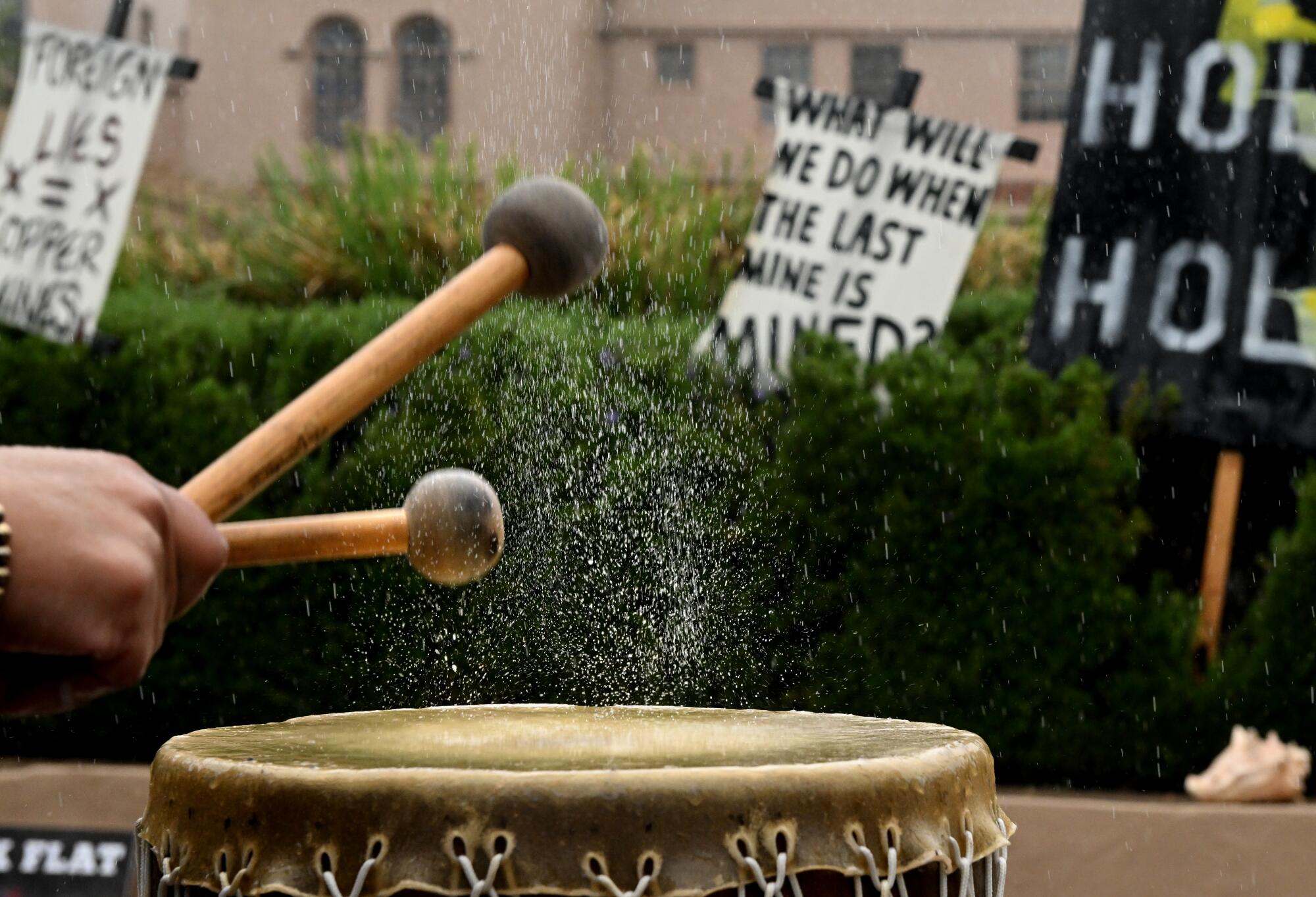
The Apache’s lawsuit is a complex one that relies on — and questions — decades of legal precedent around the rights of tribes and other religious groups.
The Apache assert that the destruction of Oak Flat would violate their treaty and place a “substantial burden” on their ability to practice their religion. Given that, they say, federal law requires that the government show a compelling government interest in the project.
They argue the government has not and cannot show such an interest, in part because the mine would most directly benefit Rio Tinto and BHP, not the U.S. government or its people.
In response, the government has argued that the 1852 treaty does not grant the Apache any rights to Oak Flat, and that even if it did, such a claim would have to be brought by a recognized tribe, not a special interest group such as Apache Stronghold.
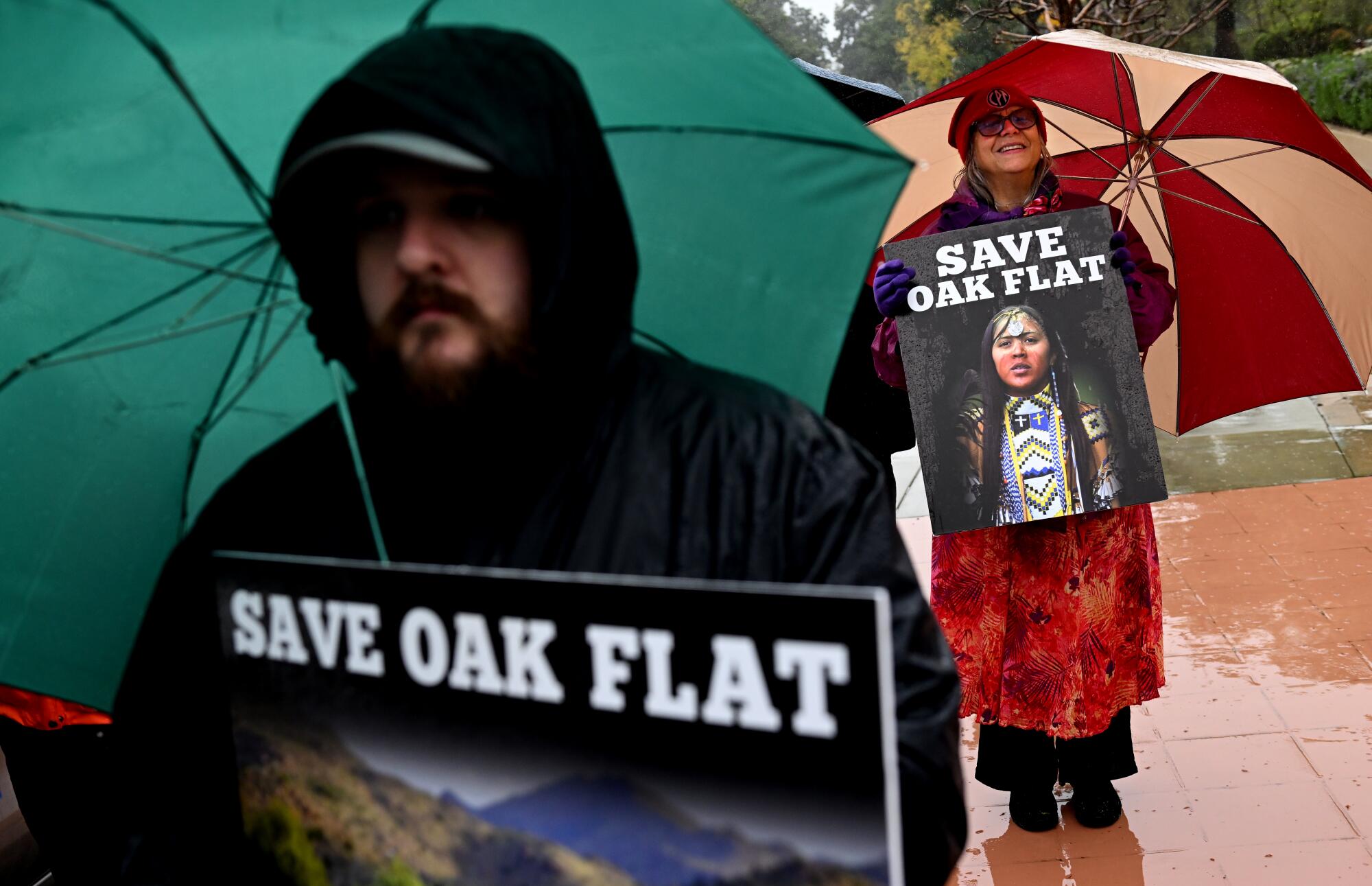
The government has argued the project does not substantially burden the Apache’s religious practice under the U.S. Supreme Court’s interpretation of such burdens because it does not “coerce” the Apache into violating their beliefs or penalize their religious activity by denying them rights or privileges enjoyed by other citizens, and therefore the government doesn’t have to prove a compelling interest in pursuing the mine deal.
The government has also warned — as have some judges reviewing the case — that allowing a small religious group to dictate how the government can use its land would set a dangerous precedent, essentially handing millions of people the power to veto federal land deals.
The case evokes a troubled past of Indigenous oppression but also a future threatened by climate change, and has inspired strange bedfellows — with conservative religious leaders from institutions such as the Church of Jesus Christ of Latter-day Saints joining with liberal activists from environmental groups such as the Sierra Club to oppose the mine.
The government has cited that interest in the case to push its point that a ruling in Apache Stronghold’s favor would inspire more special interest challenges to federal land decisions. But supporters of Apache Stronghold say such fears are overblown.
Stephanie Barclay, a law professor and director of the Religious Liberty Initiative at Notre Dame Law School, is an attorney for the National Congress of American Indians, which supports Apache Stronghold.
Barclay argues that courts have long applied a racist double standard to Indigenous religious claims, ignoring the importance of sacred lands to Indigenous people when considering whether the destruction of those lands would substantially burden their religious rights.
Courts have ruled that denying prisoners kosher meals, forcing Sikh soldiers to cut their beards, fining Amish families for keeping their children out of school and denying certain employment benefits to Seventh-day Adventists all represented substantial religious burdens.
It is solely in the context of Native American cases, Barclay said, “where the government does something to make someone’s religious exercise physically impossible, and the court says, ‘Yeah, that’s not a substantial burden.’”
Differing views
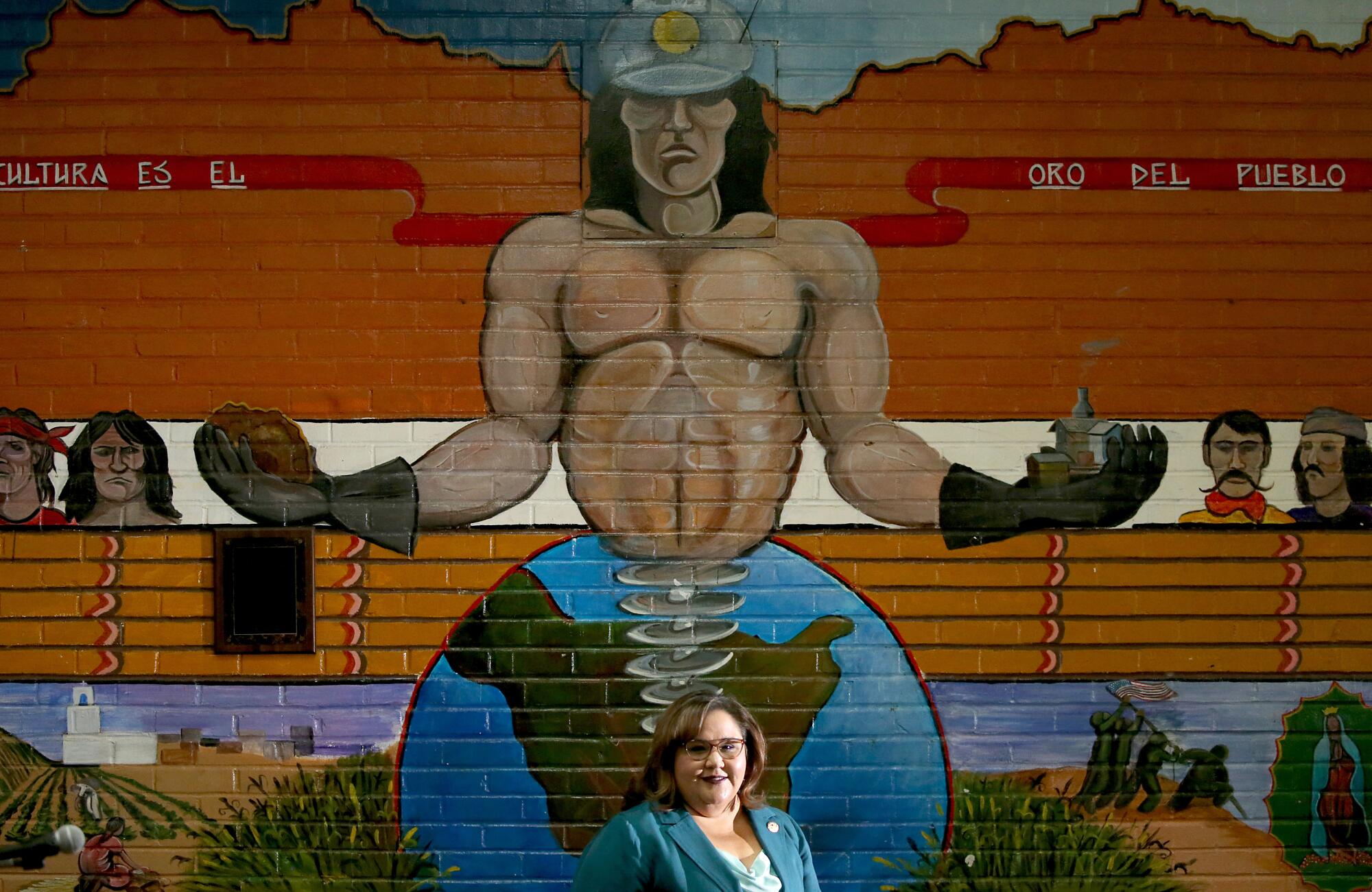
Mila Besich, 45, the Democratic mayor of Superior — population a few thousand — said she tries to be very respectful of Apache Stronghold’s fight.
But, she said, “it’s different than mine.”
Besich is a fourth-generation Superior resident, from a family with a long history of public service in the area. She remembers both her parents losing their jobs when the former Magma mine partially closed in the early 1980s, and being told after graduating from high school in 1996 that there wouldn’t be anything left of the town for her to return to after college.
Besich did return, and won a seat on the town council after her predecessor, who had spoken out against the Resolution Copper mine, was recalled. She became mayor in 2016.
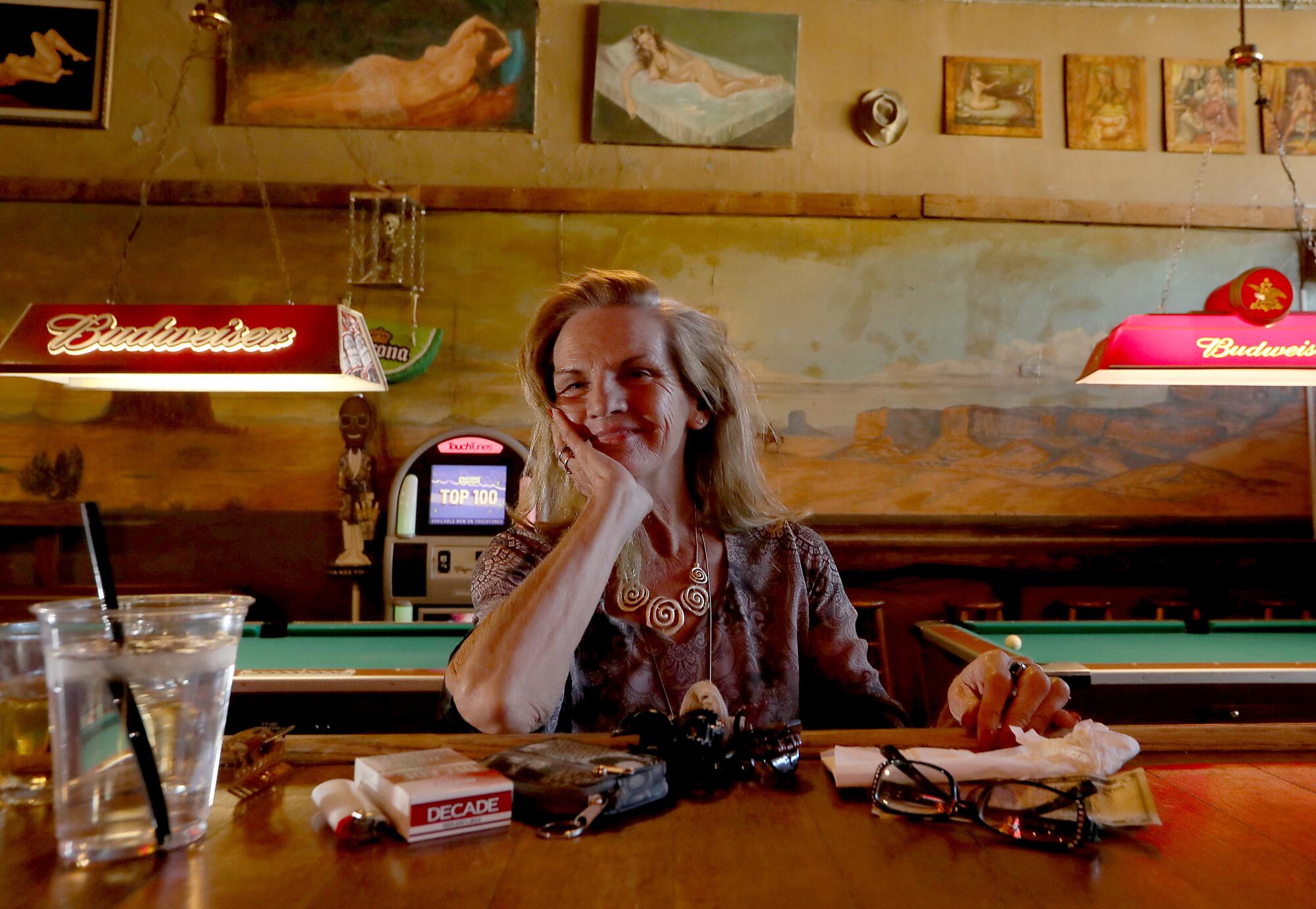
When Besich first took over, she felt like the town wasn’t getting its point of view across in all the discussions about the mine and its potential effects on the region. The federal government didn’t seem to care about how Superior felt, she said, and the town had zero working relationship with Resolution Copper.
She personally supported the mine, she said, but didn’t want to throw the town’s support behind it based on “an emotional response” to the promise of a revived town. “We had to approach this in a business sense.”
Besich and town manager Todd Pryor set out to ensure they and their staff understood the mine proposal and the federal review process. They hired an economist and started a dialogue with Resolution Copper — not just about the potential benefits of the mine but also about the threats and costs to the town.
There were water and infrastructure concerns. The town would need more police and firefighters, more money for schools, long-term assurances that roads would be maintained and help diversifying the town’s economy to ensure its survival after the mine closed, Besich said.
“One of the hardest things was to say to the mine, ‘Hey, your dog and pony show isn’t lining up with what we’re seeing,’” she said.
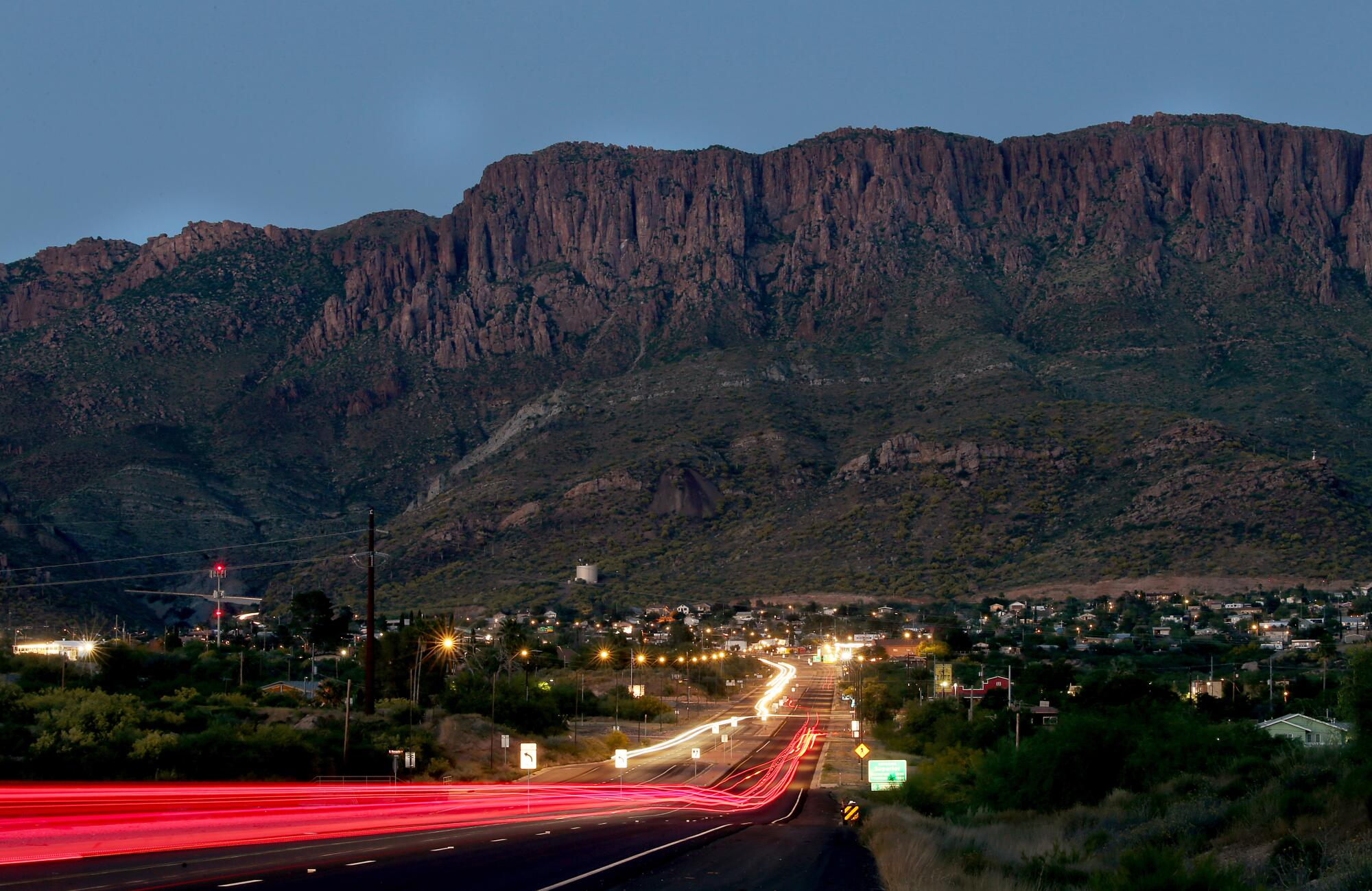
In the last six years, the company has pumped millions of dollars into Superior, including $2 million to renovate the old high school into a town hall and multi-generation center, $1.29 million for an “Enterprise Center,” $2.5 million toward other economic development and $2 million for emergency services. It also has given $300,000 a year to the school district and $50,000 a year to the Chamber of Commerce.
Over the life of the mine, Resolution Copper will pay many millions more toward emergency services and road maintenance, Besich and Pryor said, and has agreed to give the town land for a new campground and new development around Superior’s small airstrip.
Besich considers her work on the project part of her “life’s legacy.”
Around town, there is a lot of pragmatism about the project. People who came up in mining families, who comprise a lot of the population, aren’t that put off by the idea of having a mine so close to town — and are well aware of the economic benefits, which Resolution Copper says will include 3,700 jobs over the mine’s lifetime.
On a recent Saturday night, friends Jess Valenzuela, 53, and Nando Arredondo, 50, sat catching up at a bar in the heart of the town where they both grew up.
Valenzuela said his dad was “the proudest miner in the world,” who came home dirty every evening and was buried under a headstone with a miner on it.
Although his sister is adamantly opposed to the mine, having sided with the Apache, Valenzuela said he can’t help but think “that the only way we survived was Pops working his ass off” in mines, and the Resolution Copper mine could provide similar support for Superior families.
Arredondo said he understands the controversy around the mine, but he thinks it could do good things for the town. “We were raised on miners’ sweat,” he said.
The future
The timeline for the Resolution Copper mine is unclear.
The 2014 rider legislating the land swap mandates that the deal go through within 60 days of the federal government issuing its environmental statement.
In January 2021, the Trump administration issued the statement five days before President Biden’s inauguration in an effort to push the project through, but the Biden administration withdrew it that March, citing the need for additional review and consultation with tribes.
Last month, the government said it had “not yet identified a time frame for completing its review.”
Apache Stronghold filed its lawsuit days after the Trump administration published the review, asking for an emergency injunction to block the land deal.
Both a federal district court judge and a three-judge panel of the 9th Circuit denied the group’s request, but 9th Circuit judges voted in November to vacate the panel’s opinion and rehear the case “en banc,” or before an 11-judge panel.
The larger panel has yet to issue a ruling, though it could do so any day.
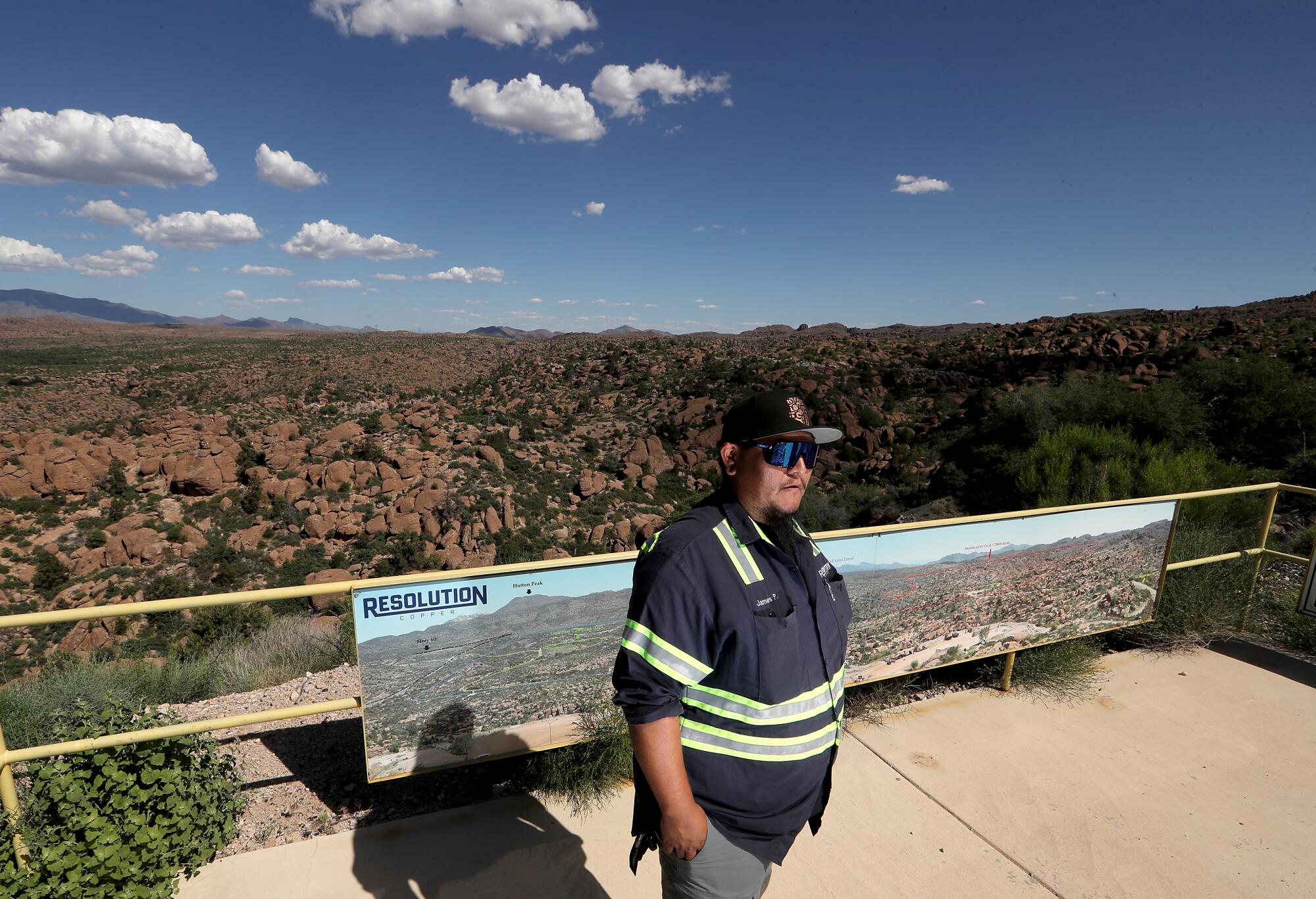
James Phillips, 33, is a member of the San Carlos Apache Tribe and a father of two. He is also a Resolution Copper employee who supports the mine.
The job has allowed him to support his family, including his aging parents, he said. It has also left him ostracized from others on the reservation, where fellow tribe members have accused him of being a “traitor” and of not caring about Apache traditions, he said.
The truth, he said, is that he just doesn’t believe what Nosie preaches about Oak Flat.
“If you were to ask me if I truly believe Oak Flat is sacred, honestly no, I don’t. I’d never heard of it being sacred before,” Phillips said.
Naelyn Pike, 23 — who is Nosie’s eldest granddaughter — feels very different.
The first time Pike testified before Congress against the Resolution Copper mine was a decade ago, when she was 13. Since then, she has become one of the faces of the fight — speaking with a gravitas beyond her years about the importance of the land for future generations.
“It’s not just an Apache fight. It’s become so much bigger,” Pike said in an interview with The Times. “It’s become a fight for humanity, a fight for ethics, about the freedom of religion. It’s about the fundamental morals of this country.”
